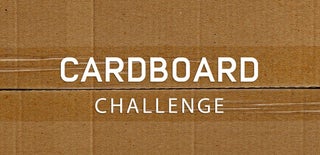Introduction: Cardboard Spinning PT-17 Stearman
One of my favorite things to do as a kid involved taping a motor and battery to a piece of wood, attaching a propeller and string, and hanging it from the ceiling. I spent many happy hours watching my airplanes flying in endless circles above my head.
Recently I found one of my old plastic propellers and resolved to make this awesome toy again. I decided to go with the PT-17 Stearman design because it is an iconic aircraft and it somewhat resembles the same spinning toy Buzz Lightyear encountered on his first flight.
In this Instructable I will show you how to easily make this simple cardboard spinning airplane.
Step 1: Supplies
Parts
- Toy motor
- Propeller
- 9 volt battery
- 9 volt battery connector
- Slide switch
- Wire
- 2 hooks
- String
Tools and supplies
- X-acto knife
- Hot glue gun
- Soldering iron and solder
- Tape
- Paint and brush
Step 2: Cut Out the Pieces
Print the PDF template and cut out the pieces. Place the pieces on the a sheet of cardboard and trace around them. I found that some of the smaller pieces will be stronger if they are placed against the grain of the corrugation inside the cardboard. You may want to use tape to keep the pieces from moving while you trace the design. After they are traced, remove the paper and cut them out with an x-acto or hobby knife.
Attachments
Step 3: Paint the Pieces
After the pieces are cut out, we will want to paint them because it will be much more difficult when the model is constructed. I decided to follow the classic paint scheme of the PT Stearman. I used spray paint for the base colors and added the rest of the details with acrylic. You only really need to worry about the visible side of the fuselage pieces.
Step 4: Wiring
Solder about 3 inches of red wire to the right terminal on the motor and the middle tab on the slide switch. If you're not sure which terminal on the motor to use, simply add power and check which direction it spins. Make sure it corresponds with your propeller.
Cut the leads on the battery connector so that they are both about 1/2 inches. Solder the positive lead to the switch and the negative on to about 2.5 inches of black wire.
Connect the battery between the two wires.
Cut any excess black wire and solder the remaining end to the motor.
Step 5: Add the Electronics
Now we can glue the electronics to the fuselage!
Place the assembly so that the motor protrudes roughly a quarter of an inch beyond the front of the fuselage. This is to leave room for the cardboard engine.
Once you are happy with where everything is positioned, hot glue the motor, battery, and switch to the inside of the fuselage.
Glue the wires to the sides of the battery to clean up any slack.
Step 6: Assemble
Glue the second fuselage piece in the same way as the first. Make sure that you leave room for the engine and the tails line up.
Fold both sides inward behind the battery to create the taper. Glue the tail ends of the fuselage together.
Glue the engine to the motor and fuselage.
Slide the horizontal stabilizer (the other tail piece) in its slot. Once it is in place, put a bead of glue in the areas where it connects with the fuselage. Wipe away any excess glue with a scrap piece of cardboard.
Glue on the bottom wing about 3/4 inch from the back of the wheels.
Glue the large wing struts 1.5 inches from the tips of the wings and the smaller ones just in front of the cockpit.
Put a bead of glue on the tops of each wing strut and attach the wing.
Step 7: Attach the String
Find the center of gravity of the plane by lifting it by the wing tips and adjust your fingers till you find the point where it balances. Screw in a hook along this line.
The performance of the airplane largely depends on the length of the string. I found that 16 inches works the best.
Cut the string to this length and attach it to the plane and the second hook.
Optional, but highly recommended: Add a fishing swivel to the string.
Step 8: Fly!
Screw the hook in the ceiling or wherever you want to showcase your aircraft.
Turn on the motor and give it a small, circular push. It may take a few tries to give it the right motion to get it flying in a circle. My plane likes to fly to the right although this could be different for you as it depends on the direction of the motor.
Once you have got it to move in stable pattern, it will continue to fly in a perfect circle for hours!
Step 9: Conclusion
Thank you for reading! If you have any questions feel free to ask in the comments.
If you have enjoyed this Instructable, please vote for it in the Cardboard Challenge!

First Prize in the
Cardboard Challenge








